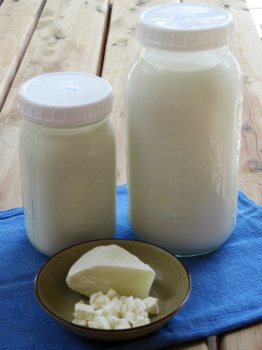Tips for Marketing Sheep and Goat Products: Dairy
NCAT Marketing Tipsheet Series
By Margo Hale and Linda Coffey, NCAT
Keeping your own dairy animals can be a great money-saving enterprise, as your animals supply food for the family as well as for orphan animals that need milk. Dairy goats are efficient at turning feed into milk, and they are personable and fun to keep.

Photo: Robyn Metzger, NCAT
Advantages
- Profit potential
- Diversified products and market opportunities
Considerations
- Labor needed to process and market milk and other dairy products
- Regulations for selling milk and facilities
- Cost of milking and processing facilities and equipment
- May require new skills—cheesemaking
Dairy enterprises are more labor-intensive than meat enterprises but also have more income potential. If you are keeping more than a few dairy animals, however, you will need a good market. There are many possibilities. Here are a few:
- Sell in bulk to a local processor
- Sell raw milk to local customers (if regulations in your state allow)
- Use milk to raise baby animals, such as calves or pigs
- Sell milk to others for animal food—puppies, foals, pigs, lambs, and calves all do well on goat’s milk
- Sell to a cheesemaker—for sheep milk, it might work to freeze and ship
- Use to make lotions or soaps (great shelf life, don’t need a commercial kitchen)
- Begin your own value-added dairy business, bottling milk or making cheese or yogurt
Scaling up to a commercial enterprise is much more demanding than keeping a few animals for home use. It is of prime importance that you first learn about all the relevant regulations in your state. Investigate the requirements for facilities and work out a cost estimate to see if a commercial enterprise will be feasible on the scale you want. For example, your dream may be to keep a dozen goats and make cheese. However, facilities that comply with regulations may be too costly and you would need to raise 200 goats to make enough cheese to pay for the facility. This changes the demands on the family and on finances and must be figured out in advance.
Regulations
Before pursuing anything other than home-scale or feeding animals, it is wise to check into the dairy regulations in your state. Rules for facilities and selling milk vary from state to state. For example, in some states you may sell limited quantities of raw milk from the farm. In another state this is forbidden. Some states also have “micro dairy” programs, which have regulations adapted to very small dairy and processing operations. See the American Dairy Goat Association listing in the Resources section for more information on finding your state’s requirements.
If you are interested in a small ruminant dairy enterprise, take these steps:
- Investigate the local markets and read the books and publications listed here.
- Talk to producers who are doing what you would like to do.
- Contact the regulatory division in your state.
- Assess the availability of labor and make a realistic plan for facilities needed and the cost of those to determine investment dollars.
While dairy enterprises can be very satisfying and can be profitable, they are the most demanding for day-to-day labor needs and facility investment.
Resources
Dairy Goats: Sustainable Production
(ATTRA publication) read for help in figuring out enterprise feasibility, budgets, and general production information.
A Guide to Starting a Commercial Goat Dairy by Carol Delaney.
This book, published in 2012, is a great all-around resource, including economic information.
The Farmstead Creamery Advisor: The Complete Guide to Building and Running a Small, Farm-Based Cheese Business by Gianaclis Caldwell (Chelsea Green Publishing).
If you are considering producing and selling cheese, this book is an excellent resource. It covers:
- Analyzing your suitability for the career
- Designing and building the cheese facility
- Sizing up the market
- Negotiating day-to-day obstacles
- Ensuring maximum safety and efficiency
American Dairy Goat Association
This website has a database to help you contact the appropriate regulatory agency in your state. Click on “About Dairy Goats,” then scroll down to select “State Contacts for Starting a Grade A/B Goat Dairy.” Those are the same contacts for starting a sheep dairy. This is also where you go to learn about the raw milk rules in your state.
Dairy Sheep Association of North America
From this site, you can learn about the annual Dairy Sheep Symposium, which is an excellent educational opportunity. The DSANA has a newsletter and includes links to more information and to members and researchers who can help answer questions.
Wisconsin Extension—Sheep Dairy Information
This website includes proceedings from previous Dairy Sheep symposia (listed under the former name, Great Lakes Dairy Sheep Symposium). Some of this information is relevant to dairy goat producers as well.
Tips for Marketing Sheep and Goat Products: Dairy
© 2012 National Center for Appropriate Technology—NCAT
By Margo Hale and Linda Coffey, NCAT
IP396
This publication is produced by the National Center for Appropriate Technology through the ATTRA Sustainable Agriculture program, under a cooperative agreement with USDA Rural Development. This publication was also made possible in part by funding from USDA/NIFA/OASDFR. ATTRA.NCAT.ORG.


